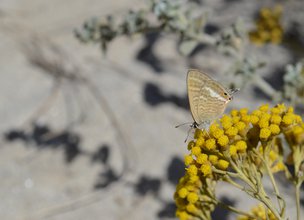A biotope with unique characteristics in the North Coast.
The Montedor Promontory appears in the parish of Carreço, marking the beginning of the sandy beach sector in the north and the end of rocky beaches in the south. It consists of an elevation of the coastal zone, where a typical biotope of rocky outcrops occurs, with unique characteristics in the North Coast. It corresponds to the habitat “Cliffs with vegetation on the Atlantic and Baltic coasts” (Code 1230), where there is a coastal heather-gorse of the Cisto salviifolii-Ulicetum humilis alliance.
It is an area of high environmental importance and nature conservation, with the existence of some unusual species of avifauna and flora.
Monte de Montedor has been inhabited since prehistory, having undergone an intense human occupation since the Iron Age, proven by archaeological remains. Despite this, it is considered a space with a high degree of conservation, with trampling being an obvious threat. However, plants of the genus Acacia have been proliferating and invading this space in a worrying manner and at a considerable speed, which may put the conservation of this ecosystem at risk.
In this place, inserted in the North Coast Special Conservation Zone, there is a habitat contained in the Habitats Directive:
1230 - Cliffs with vegetation on the Atlantic and Baltic coasts.
The Montedor Promontory appears in the parish of Carreço, marking the beginning of the sandy beach sector in the north and the end of rocky beaches in the south. It consists of an elevation of the coastal zone, where a typical biotope of rocky outcrops occurs, with unique characteristics in the North Coast. It corresponds to the habitat “Cliffs with vegetation on the Atlantic and Baltic coasts” (Code 1230), where there is a coastal heather-gorse of the Cisto salviifolii-Ulicetum humilis alliance.
It is an area of high environmental importance and nature conservation, with the existence of some unusual species of avifauna and flora.
Monte de Montedor has been inhabited since prehistory, having undergone an intense human occupation since the Iron Age, proven by archaeological remains. Despite this, it is considered a space with a high degree of conservation, with trampling being an obvious threat. However, plants of the genus Acacia have been proliferating and invading this space in a worrying manner and at a considerable speed, which may put the conservation of this ecosystem at risk.
In this place, inserted in the North Coast Special Conservation Zone, there is a habitat contained in the Habitats Directive:
1230 - Cliffs with vegetation on the Atlantic and Baltic coasts.
Location
The Montedor Promontory is located in the parish of Carreço, in Viana do Castelo.
Coordinates
Lat: 41.750472
Long: -8.878556
Hello little one!
I'm Piquinhos and I can help you learn more about the Geopark!
Biodiversity
Biodiversity
There are endemic species, such as Armeria pubigera, that appear mainly in the belt most exposed to the effect of the sea. In the innermost area, typical gorse-heaths appear from exposed cliffs, dominated by Ulex europaeus subsp. latebracteatus f. humilis.
The small vegetation characteristic of this area ensures the habitat of a great diversity of invertebrates and small reptiles. Several species of hymenoptera occur on the promontory, such as the carder bee (Bombus pascuorum), the honey bee (Apis mellifera), the cuckoo wasp (Parnopes grandior), the sand wasp (Bembix sp.) And the sweating wasp (Halictus sp.). Several species of butterflies can also be observed, such as Lampides boeticus, Euphydryas aurinia, Hipparchia fidia and Vanessa cardui.
There are also the Iberian emerald lizard (Lacerta schreiberi) and the northern lizard (Podarcis guadarramae), Iberian endemisms, among other species of reptiles.
Discover some of the species that can be found in this location, under the "Multimedia" tab.
Child Mode
Discover the geopark in a simpler format, aimed at the little ones.
Clique ENTER para pesquisar ou ESC para sair
